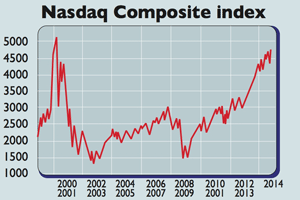
The bulls have been out in force on Wall Street this year. The S&P has hit almost 40 new record highs in 2014; the Dow Jones index has notched up more than 20. But we don’t hear much about the Nasdaq Composite, the main gauge of the technology-dominated Nasdaq stock exchange.
At the peak of the dotcom bubble, on 10 March 2000, the Nasdaq reached 5,049 – an all-time high. But then the bubble burst, wiping 80% off the index, and enthusiasm vanished. Yet now, having climbed by a fifth in the past year, it is less than 10% from its record.
In a few months, it will probably have eclipsed it, a milestone many money managers and analysts thought they’d never see.
Today’s Nasdaq is “a far cry” from the “bloated dotcom” symbol it was then, notes Alexander Eule in Barron’s. For one thing, it’s down to 2,565 components, around half its dotcom size.
Acquisitions, scandals and bankruptcies (many of which featured in MoneyWeek’s ‘dotcom disaster of the week’ column back then) account for the shrinkage.
It has also diversified. Tech still comprises half the index, but consumer discretionary and healthcare stocks now account for 17% and 16% of the market respectively.
Revived dotcom darlings such as Amazon, new stars such as Facebook, and established giants such as Intel and Cisco all feature. “Tech is now an animal it has never been before,” says Jim Paulsen of Wells Capital Management.
“We still have companies at the leading edge of new ideas, but we also see a host of almost utility-like tech giants that are generating lots of cash, whileno longer innovating.” This solid mix of old and new is pushing the market higher.
Another difference between the 2000 edition of the Nasdaq and today’s is that technology analysts, who helped inflate the original bubble by overhyping rubbish, have reformed, says Brian Belski of BMO Capital Markets. They’re now “among the most cautious analysts on the Street”, he reckons.
Last but not least, valuations are now far more reasonable, despite the occasional speck of froth. In 2000, the index reached a price-to-sales ratio of almost 6; now it’s 2.2. The price/earnings (p/e) ratio is 23, compared to 175.
You even get a small dividend yield now: 1.5%. At the turn of the century, the payout was 0.3%, noted Eule. So don’t expect another slump once we hit the old record. “The Nasdaq has matured.”